标签:不能 解析 内部函数 文件 catch ext frame info j2ee
FreeMarker是一个用Java语言编写的模板引擎,它基于模板来生成文本输出。FreeMarker与Web容器无关,即在Web运行时,它并不知道Servlet或HTTP。它不仅可以用作表现层的实现技术,而且还可以用于生成XML,JSP或Java 等。目前企业中:主要用Freemarker做静态页面或是页面展示。
以下都是网上摘要,感觉很有用,适合初学者了解
把freemarker的jar包添加到工程中
<dependency> <groupId>org.freemarker</groupId> <artifactId>freemarker</artifactId> <version>2.3.23</version> </dependency>
首先需要添加freemarker.jar到项目,如果项目中有spring或者spirngmvc,需要整合,首先配置freemarkerConfig,代码结构如下:
<!-- 设置freeMarker的配置文件路径 -->
<bean id="freemarkerConfiguration"
class="org.springframework.beans.factory.config.PropertiesFactoryBean">
<property name="location" value="classpath:freemarker.properties" />
</bean>
<bean id="freemarkerConfig"
class="org.springframework.web.servlet.view.freemarker.FreeMarkerConfigurer">
<property name="freemarkerSettings" ref="freemarkerConfiguration" />
<property name="templateLoaderPath">
<value>/WEB-INF/freemarker/</value>
</property>
<property name="freemarkerVariables"><!--设置一些常用的全局变量-->
<map>
<entry key="xml_escape" value-ref="fmXmlEscape" />
<entry key="webRoot" value="/shop"></entry>
<entry key="jsRoot" value="/shop/js"></entry>
</map>
</property>
</bean>
其中一下代码是用来扫描.ftl的模板文件,在/web-info/freemarker目录中
<property name="templateLoaderPath">
<value>/WEB-INF/freemarker/</value>
</property>
然后freemarker用ftl文件来呈现视图,这时候就需要配置freemarker的视图解析器,代码如下:
<!-- 配置freeMarker视图解析器 -->
<bean id="freemarkerViewResolver"
class="org.springframework.web.servlet.view.freemarker.FreeMarkerViewResolver">
<property name="viewClass" value="org.springframework.web.servlet.view.freemarker.FreeMarkerView"
/>
<property name="viewNames" value="*.ftl" />
<property name="contentType" value="text/html; charset=utf-8" />
<property name="cache" value="true" />
<property name="suffix" value="" />
<!-- <property name="exposeRequestAttributes" value="true" />
<property name="exposeSessionAttributes" value="true" />
<property name="exposeSpringMacroHelpers" value="true" /> -->
<property name="order" value="0" />
</bean>
<!-- 对模型视图名称的解析,即在模型视图名称添加前后缀 通用解析器 -->
<bean id="viewResolver"
class="org.springframework.web.servlet.view.InternalResourceViewResolver">
<property name="prefix" value="" />
<property name="viewNames" value="*.html,*.jsp" />
<property name="suffix" value="" />
<property name="viewClass"
value="org.springframework.web.servlet.view.InternalResourceView" />
<property name="order" value="1"></property>
</bean>
其中:<property name="order" value="0">代表了第一个匹配的是freemarker的视图解析器,如果匹配不成功,则自动选择order=1的其他解析器,目前的通用解析器可以解析.html跟.jsp的视图,如果需要其他视图的解析器,可以自行添加。
其中的exposeRequestAttributes exposeSessionAttributes两个属性都被设置为true。结果是请求和会话属性都被复制到模板的属性集中,可以使用FreeMarker的表达式语言来访问并显示。
使用这些宏,必须设置FreeMarkerViewResolver的exposeSpringMacroHelpers属性为true
以上是freemarker与springmvc整合需要配置的xml文件。
下面来介绍一下在Java 代码中如何使用:
首先编写Freemarker的工具类,用来生成HTML文件的方法:
package com.hc.shop.common.tools; import java.io.File; import java.io.FileNotFoundException; import java.io.FileOutputStream; import java.io.IOException; import java.io.OutputStreamWriter; import java.io.UnsupportedEncodingException; import java.io.Writer; import java.util.HashMap; import java.util.Map; import javax.servlet.http.HttpServletRequest; import org.springframework.web.servlet.view.freemarker.FreeMarkerConfig; import freemarker.template.Template; import freemarker.template.TemplateException; /** * @author HuifengWang 静态化方法 **/ public class FreeMarkerUtil { /** * * 生成HTML静态页面的公公方法 * @param fmc * @param templateName 模板的名称 * @param request * @param map 生成模板需要的数据 * @param filePath 相对于web容器的路径 * @param fileName 要生成的文件的名称,带扩展名 * @author HuifengWang * */ public static void createHtml(FreeMarkerConfig fmc, String templateName, HttpServletRequest request, Map<?, ?> map, String filePath, String fileName) { Writer out = null; try { Template template = fmc.getConfiguration() .getTemplate(templateName); String htmlPath = request.getSession().getServletContext() .getRealPath(filePath) + "/" + fileName; File htmlFile = new File(htmlPath); if (!htmlFile.getParentFile().exists()) { htmlFile.getParentFile().mkdirs(); } if (!htmlFile.exists()) { htmlFile.createNewFile(); } out = new OutputStreamWriter(new FileOutputStream(htmlPath),"UTF-8"); template.process(map, out); out.flush(); } catch (UnsupportedEncodingException e) { e.printStackTrace(); } catch (FileNotFoundException e) { e.printStackTrace(); } catch (IOException e) { e.printStackTrace(); } catch (TemplateException e) { e.printStackTrace(); } finally { try { out.close(); out = null; } catch (IOException e) { e.printStackTrace(); } } } /** * @param request * @param filePath 文件存放的路径 * @param fileName 文件的名称,需要扩展名 * @author HuifengWang * @return */ public static Map<String,Object> htmlFileHasExist(HttpServletRequest request,String filePath, String fileName) { Map<String,Object> map = new HashMap<String,Object>(); String htmlPath = request.getSession().getServletContext() .getRealPath(filePath) + "/" + fileName; File htmlFile = new File(htmlPath); if(htmlFile.exists()){ map.put("exist", true); }else{ map.put("exist",false); } return map ; } }
以上就是要生成HTML文件的工具类,参数注解都有,应该很好理解。
如何在Controller中调用??下面来看一个很简单的demo
@Autowired private FreeMarkerConfig freeMarkerConfig;//获取FreemarkerConfig的实例 @RequestMapping("/ttt") public String ttt(HttpServletRequest request,HttpServletResponse response,ModelMap mv) throws IOException, TemplateException, ServletException{ String fileName ="ttt.html"; Boolean flag =(Boolean)FreeMarkerUtil.htmlFileHasExist(request, FREEMARKER_PATH, fileName).get("exist"); if(!flag){//如何静态文件不存在,重新生成 Map<String,Object> map = new HashMap<String,Object>(); map.put("user", "xiaowang小王");//这里包含业务逻辑请求等 mv.addAllAttributes(map); FreeMarkerUtil.createHtml(freeMarkerConfig, "demo.ftl", request, map, FREEMARKER_PATH, fileName);//根据模板生成静态页面 } return FREEMARKER_PATH+"/"+fileName;//始终返回生成的HTML页面 }
以上就是如何在springmvc中使用Freemarker的具体实现方式
那在springboot项目中如何整合呢
搭建springboot的web项目可以用idea搭建
<dependency>
<groupId>org.springframework.boot</groupId>
<artifactId>spring-boot-starter-freemarker</artifactId>
</dependency>
server.port=8080
spring.freemarker.allow-request-override=false
spring.freemarker.cache=true
spring.freemarker.check-template-location=true
spring.freemarker.charset=UTF-8
spring.freemarker.content-type=text/html
spring.freemarker.expose-request-attributes=false
spring.freemarker.expose-session-attributes=false
spring.freemarker.suffix=.html
spring.freemarker.templateEncoding=UTF-8
spring.freemarker.templateLoaderPath=classpath:/templates/
spring.freemarker.expose-spring-macro-helpers=false
1) 控制层代码
import java.text.SimpleDateFormat; import java.util.ArrayList; import java.util.Date; import java.util.HashMap; import java.util.List; import java.util.Map; import org.springframework.stereotype.Controller; import org.springframework.web.bind.annotation.RequestMapping; /** * ClassName:StudentController * Date: 2017年11月6日 下午4:27:40 * @author Joe * @version * @since JDK 1.8 */ @Controller public class StudentController { /** * freemarker:(跳转到 freemarker.ftl). * @author Joe * Date:2017年11月6日下午4:52:19 * * @param map * @return */ @RequestMapping("/freemarker") public String freemarker(Map<String, Object> map){ map.put("name", "Joe"); map.put("sex", 1); //sex:性别,1:男;0:女; // 模拟数据 List<Map<String, Object>> friends = new ArrayList<Map<String, Object>>(); Map<String, Object> friend = new HashMap<String, Object>(); friend.put("name", "xbq"); friend.put("age", 22); friends.add(friend); friend = new HashMap<String, Object>(); friend.put("name", "July"); friend.put("age", 18); friends.add(friend); map.put("friends", friends); return "freemarker"; } }
2)在main\resources\templates 目录下 新建 freemarker.ftl 文件,也可以是html的后缀,内容如下:
<!DOCTYPE html> <html xmlns="http://www.w3.org/1999/xhtml" xmlns:th="http://www.thymeleaf.org" xmlns:sec="http://www.thymeleaf.org/thymeleaf-extras-springsecurity3"> <head> <title>Hello World!</title> </head> <body> <center> <p> welcome ${name} to freemarker! </p> <p>性别: <#if sex==0> 女 <#elseif sex==1> 男 <#else> 保密 </#if> </p> <h4>我的好友:</h4> <#list friends as item> 姓名:${item.name} , 年龄${item.age} <br> </#list> </center> </body> </html>
通过freemarker生成word文件
<!--添加freeMarker-->
<dependency>
<groupId>org.freemarker</groupId>
<artifactId>freemarker</artifactId>
<version>2.3.20</version>
</dependency>
下一步我们要做的是先好我们的word模板然后将模板转换为xml文件。在word模板中需要定义好我们的占位符哦,使用${string}的方式。“string”根据自己的爱好定义就好了。
过程如下:
word文档:
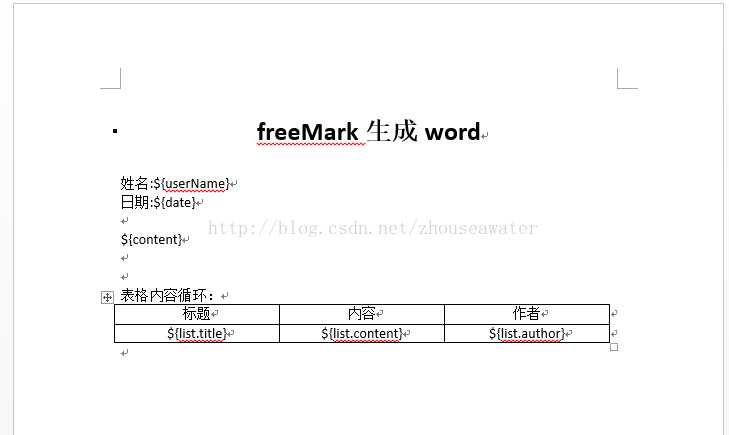
然后将我们的word文档另存为xml文档。
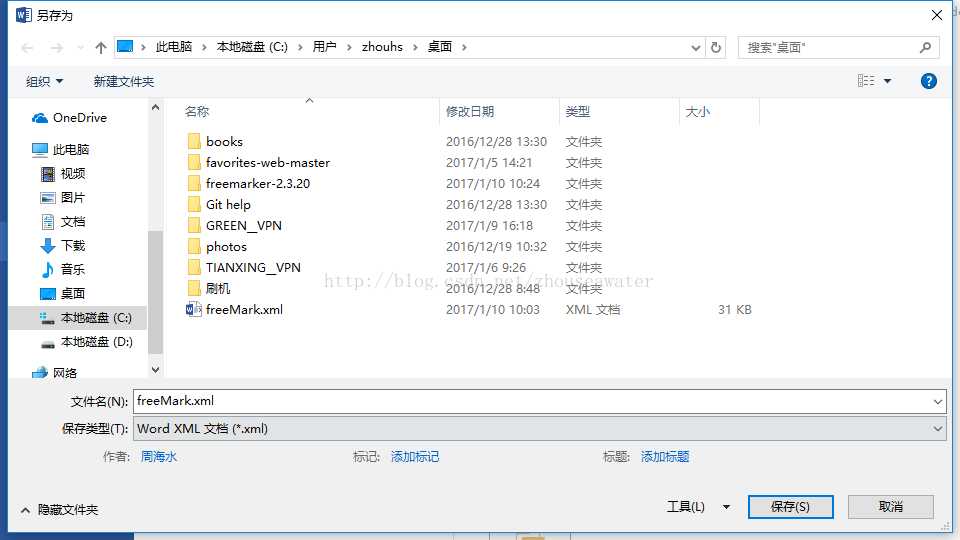
将我们的xml文档的后缀改为ftl,然后用可以打开ftl文件的软件打开我们的ftl文件。在这里我们有几个需要注意的地方。
第一,定义的占位符可能会被分开了。就像下面这样:
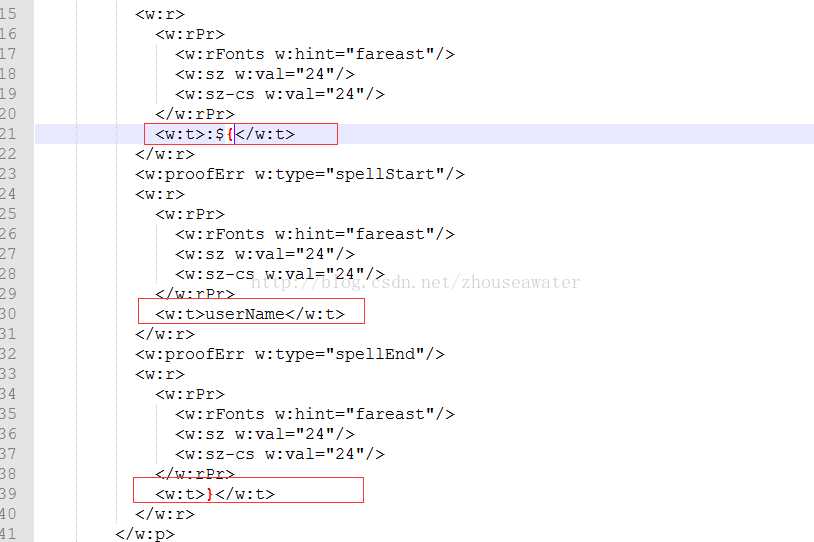
我们需要做的就是删掉多余的部分,图中我定义的是${userName}.所以我就把多余的删掉,变成${userName}就可以了。
第二,我们需要注意的就是在我们的表格部分需要自己添加freeMarker标签。在表格代码间用自定的标签括起来。定义的参数要和我们在方法中定义的一致,否则无法取到值。
表格开始:
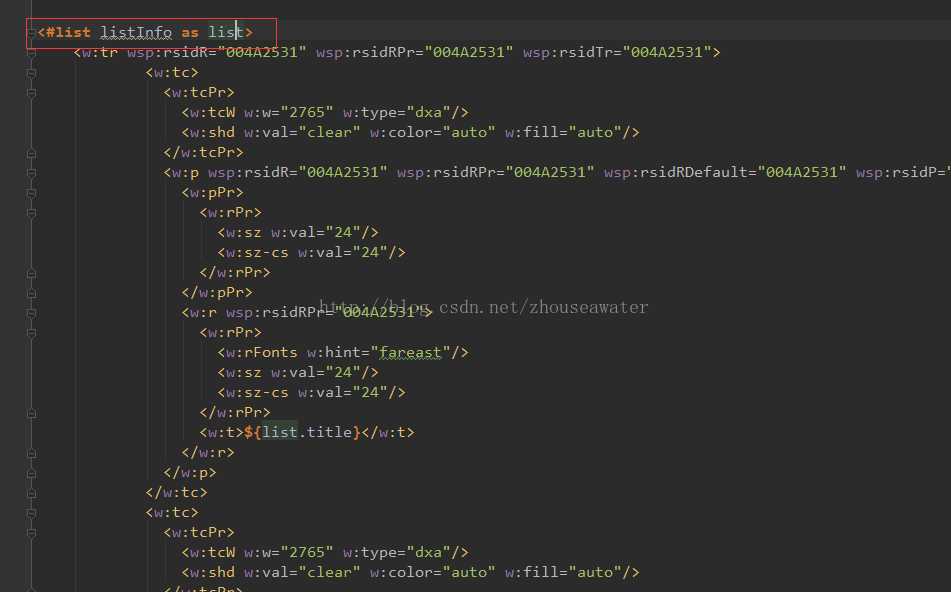
结束:</list>
package czc.sup.system.model.six; import freemarker.template.Configuration; import freemarker.template.Template; import java.io.*; import java.util.Map; public class WordUtil { /** * 生成word文件 * @param dataMap word中需要展示的动态数据,用map集合来保存 * @param templateName word模板名称,例如:test.ftl * @param filePath 文件生成的目标路径,例如:D:/wordFile/ * @param fileName 生成的文件名称,例如:test.doc */ @SuppressWarnings("unchecked") public static void createWord(Map dataMap,String templateName,String filePath,String fileName){ try { //创建配置实例 Configuration configuration = new Configuration(); //设置编码 configuration.setDefaultEncoding("UTF-8"); //ftl模板文件 configuration.setClassForTemplateLoading(WordUtil.class,"/"); //获取模板 Template template = configuration.getTemplate(templateName); //输出文件 File outFile = new File(filePath+File.separator+fileName); //如果输出目标文件夹不存在,则创建 if (!outFile.getParentFile().exists()){ outFile.getParentFile().mkdirs(); } //将模板和数据模型合并生成文件 Writer out = new BufferedWriter(new OutputStreamWriter(new FileOutputStream(outFile),"UTF-8")); //生成文件 template.process(dataMap, out); //关闭流 out.flush(); out.close(); } catch (Exception e) { e.printStackTrace(); } } }
public static void main(String[] args) { /** 用于组装word页面需要的数据 */ Map<String, Object> dataMap = new HashMap<String, Object>(); DataWord dataWord = new DataWord("model", "name", "designCode", "code", "met", "date", "temp", "humi", "hly"); List<Object> datas = new ArrayList<>(); for(int i=0;i<10;i++){ Data data = new Data("1","检测名"+i, "norm", "result", "remark"); datas.add(data); } dataMap.put("product",dataWord); dataMap.put("datas",datas); String filePath = ""; if (IsWhatSystem.whatSystem()) { //文件路径 filePath = "D:/doc_f/"; }else { filePath = "/doc_f/"; } //文件唯一名称 String fileOnlyName = "生成Word文档.doc"; /** 生成word 数据包装,模板名,文件生成路径,生成的文件名*/ WordUtil.createWord(dataMap, "quality.ftl", filePath, fileOnlyName); }
然后就在相应的目录下导出word文档了
通过freemarker生成excel文件
第一步:添加依赖
<dependency> <groupId>org.freemarker</groupId> <artifactId>freemarker</artifactId> <version>2.3.20</version> </dependency>
第二步:把excel另存为xml
在这里我要说一下,excel在另存为xml时里面的图片会丢失,它并不会像word那样生成一个占位符。所以我这个导出的excel是没有图片的。言归正传,这就是我另存为的xml的样例,其中row为行,cell为单元格

第三步:把要插入的数据使用freemarker的标签----${}替换
看到这里的${},是不是觉得它很像jstl标签,它的用法确实和jstl差不多,jstl是获取session中的值,而他是获取dataMap中的值;而且都是可以循环的便利的,它的便利标签就是
<#list list as item><#--其中list为你后台在dataMap中的key--> <#if item.detaildata??><#--判断是否为空,如果不为空则显示内容--> <#--${item.detaildata}是获取list的子元素的值--> <Cell ss:StyleID="s37"><Data ss:Type="String">${item.detaildata}</Data></Cell> <#else><#--否则显示空的单元格--> <Cell ss:StyleID="s37"/> </#if> </#list>
如图
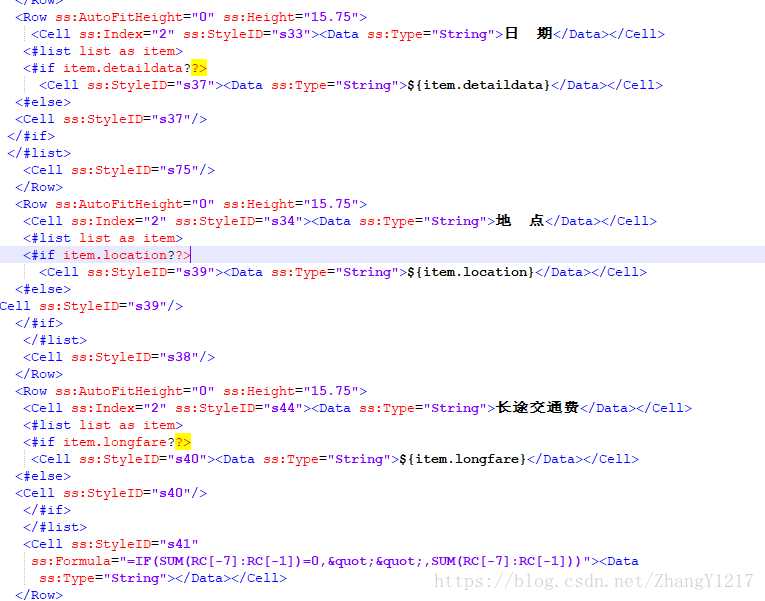
第四步:把xml的后缀名改成ftl,并且在webapp中新建template,把xxx.ftl,放到里面
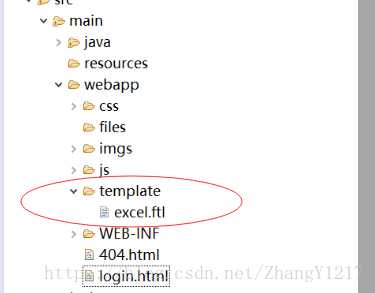
好了基本的操作已经做完了,下面就是后台代码了。因为我的项目是MVC的设计理念并没有使用任何框架,所以把后台分为了四个层面:数据库对象序列化(dto),数据库访问层(DAO),数据处理层(service),控制层(servlet),算了还是用一个简单的例子吧,我开发的项目可能就要从头讲了。废话不多说先上service的代码,是一个封装好的类,可以直接调用的:
public class ExportExcelService {
public static void export(String templatePath, Map<String, Object> dataMap,
String buildFile, String newName,HttpServletRequest request,HttpServletResponse response) {
try {
ServletContext application = request.getSession().getServletContext();
Configuration configuration = new Configuration();
configuration.setDefaultEncoding("utf-8");
String path = application.getRealPath("template");
// 此处是本类Class.getResource()相对于模版文件的相对路径
configuration.setDirectoryForTemplateLoading(new File(path));
Template template = null;
File outFile = new File(buildFile);
Writer writer = null;
template = configuration.getTemplate(templatePath);
template.setEncoding("utf-8");
writer = new BufferedWriter(new OutputStreamWriter(
new FileOutputStream(outFile), Charset.forName("utf-8")));// 此处为输
template.process(dataMap, writer);
writer.flush();
writer.close();
// return true;
// 设置response的编码方式
response.setContentType("application/x-msdownload");
// 设置附加文件名
response.setHeader("Content-Disposition", "attachment;filename="
+ new String(newName.getBytes("utf-8"), "iso-8859-1"));
// 读出文件到i/o流
FileInputStream fis = new FileInputStream(outFile);
BufferedInputStream buf = new BufferedInputStream(fis);
byte[] b = new byte[1024];// 相当于我们的缓存
long k = 0;// 该值用于计算当前实际下载了多少字节
// 从response对象中得到输出流,准备下载
OutputStream myout = response.getOutputStream();
// 开始循环下载
while (k < outFile.length()) {
int j = buf.read(b, 0, 1024);
k += j;
// 将b中的数据写到客户端的内存
myout.write(b, 0, j);
}
// 将写入到客户端的内存的数据,刷新到磁盘
myout.flush();
myout.close();
} catch (Exception e) {
e.printStackTrace();
// return false;
}
}
}
然后我们在servlet中调用这个类中的方法,重点就看我标黄的代码,这个是自己生成的list,而不是通过其他代码生成的,标蓝色的则是单一的键值对,红色代码为如果导出的数据不是模板的7天数据,则自动补充不足的空数据,以完成模板显示空单元格如下:
@WebServlet("/excelExport")
public class exportExcelServlet extends HttpServlet {
private static final long serialVersionUID = 1L;
@Override
protected void doGet(HttpServletRequest req, HttpServletResponse resp) throws ServletException, IOException {
String uz=new String(URLDecoder.decode(req.getParameter("uz"),"utf-8"));
ReimburseService res=new ReimburseService();
String[] data=uz.split(",");
String uname=uz.split(",")[1];
String weeknumber=uz.split(",")[0];
Model model=res.querydetail(uname, weeknumber);
Map<String, Object> dataMap = new HashMap<String, Object>();
dataMap.put("username",uz.split(",")[2]);
dataMap.put("writedata",uz.split(",")[3]);
dataMap.put("appartment",uz.split(",")[4]);
List list=(List) model.getData();
for(int i=list.size();i<7;i++){
ReimburseDetail rd=new ReimburseDetail();
rd.setDetaildata("");
rd.setHotelfare("");
rd.setLocation("");
rd.setLongfare("");
rd.setOtherfare("");
rd.setShortfare("");
rd.setProject("");
rd.setFaredescription("");
list.add(rd);
}
//对list进行排序
for(int i=0;i<list.size();i++){
ReimburseDetail rdl=(ReimburseDetail)list.get(i);
try {
if(!rdl.getDetaildata().equals("")){
int b=dayForWeek(rdl.getDetaildata());
if(b-1!=i){
Object objA= list.get(i);
list.set(i, list.get(b-1));
list.set(b-1, objA);
}
}
} catch (Exception e) {
// TODO Auto-generated catch block
e.printStackTrace();
}
}
dataMap.put("list",list);
List ls=new ArrayList();
String[] num={"A","B","C","D","E","F","G"};
String[] Formula={"-9","-10","-11","-12","-13","-14","-15"};
for(int i=0;i<num.length;i++){
Map<String,Object> map = new HashMap<String,Object>();
map.put("num",num[i]);
ReimburseDetail r=(ReimburseDetail)list.get(i);
map.put("faredescription",r.getFaredescription());
map.put("Formula", Formula[i]);
map.put("col", i+1);
ls.add(map);
}
dataMap.put("ls",ls);
ServletContext application = req.getSession().getServletContext();
/*********输出图片未解决********************/
String a=application.getRealPath("imgs");
String img = getImageStr(a+"/ceit.png");
dataMap.put("image", img);
/***********************************/
String templateName = "excel.ftl"; //模板名称
java.text.DateFormat format1 = new java.text.SimpleDateFormat("yyyy-MM-dd");
String exportexcel = application.getRealPath("template")+format1.format(new Date())+ ".xls";
ExportExcelService.export(templateName, dataMap, exportexcel, "每周报销单("+format1.format(new Date())+").xls",req,resp);
}
/***************获取日期是星期几*************************/
public static int dayForWeek(String pTime) throws Exception {
SimpleDateFormat format = new SimpleDateFormat("yyyy-MM-dd" );
Calendar c = Calendar.getInstance();
c.setTime(format.parse(pTime));
int dayForWeek = 0 ;
if (c.get(Calendar.DAY_OF_WEEK) == 1 ){
dayForWeek = 7 ;
}else {
dayForWeek = c.get(Calendar.DAY_OF_WEEK) - 1 ;
}
return dayForWeek;
}
/**************将图片转成base64********************/
public String getImageStr(String imgFile) {
InputStream in = null;
String da="";
byte[] data = null;
try {
in = new FileInputStream(imgFile);
data = new byte[in.available()];
in.read(data);
in.close();
da=new String(Base64.encodeBase64(data),"UTF-8");
} catch (FileNotFoundException e) {
// TODO Auto-generated catch block
e.printStackTrace();
} catch (IOException e) {
// TODO Auto-generated catch block
e.printStackTrace();
}
return da;
}
}
注意:使用freemaker,要求所有标签必须闭合,否则会导致freemaker无法解析。
freemaker注释:<#– 注释内容 –>格式部分,不会输出
${emp.name?if_exists} // 变量存在,输出该变量,否则不输出
${emp.name!} // 变量存在,输出该变量,否则不输出
${emp.name?default("xxx")} // 变量不存在,取默认值xxx
${emp.name!"xxx"} // 变量不存在,取默认值xxx
常用内部函数:
${"123<br>456"?html} // 对字符串进行HTML编码,对html中特殊字符进行转义
${"str"?cap_first} // 使字符串第一个字母大写
${"Str"?lower_case} // 将字符串转换成小写
${"Str"?upper_case} // 将字符串转换成大写
${"str"?trim} // 去掉字符串前后的空白字符
字符串的两种拼接方式拼接:
$ { “你好$ {emp.name!}”} //输出你好+变量名
$ {“hello”+ emp.name!} //使用+号来连接,输出你好+变量名
可以通过如下语法来截取子串:
<#assign str =“abcdefghijklmn”/> //方法1 $ {str?substring(0,4)} //输出abcd //方法2 $ { str [ 0 ] } $ {str [4]} //结果是ae $ {str [1..4]} //结果是bcde //返回指定字符的索引 $ {str?index_of("n")}
$ {emp.date?string(‘yyyy -MM-dd‘)} //日期格式
$ {emp.name?string.number} //输出20
$ {emp.name?string.currency} //¥20.00
$ {emp.name?string.percent} // 20%
$ {1.222?int} //将小数转为int,输出1
<#setting number_format =“percent”/> //设置数字默认输出方式(‘percent‘,百分比)
<#assign answer = 42 /> //声明变量回答42
#{answer} //输出4,200%
$ {answer?string} //输出4,200%
$ {answer?string.number} //输出42
$ {answer?string.currency} //输出¥42.00
$ {answer?string.percent} //输出4,200%
#{answer} //输出42
数字格式化插值可采用#{expr; format}形式来格式化数字,其中格式可以是:
mX:小数部分最小X位
MX:小数部分最大X位
如下面的例子:
<#assign x = 2.582 /> <#assign y = 4 />
# {x; M2} //输出2.58
# {y; M2} //输出4
# {x; m2} //输出2.58
#{Y; m2} //输出4.0
# {x; m1M2} //输出2.58
# {x; m1M2} //输出4.0
<#assign foo = false /> //声明变量,插入布尔值进行显示,注意不要用引号 $ {foo?string(“yes”,“no”)} //当为真时输出“yes”,否则输出“no”
申明变量的几种方式
<#assign name = value> <#assign name1 = value1 name2 = value2 ... nameN = valueN> <#assign same as above... in namespacehash> <#assign name> capture this </#assign> <#assign name in namespacehash> capture this </#assign>
表达式中支持的比较运算符符如下几个: =或==:判断两个值是否相等。 !=:判断两个值是否不等。 >或gt:判断左边值是否大于右边值> <=或lte:判断左边值是否小于等于右边值
FreeMarker表达式中完全支持算术运算, FreeMarker支持的算术运算符包括:+, - ,*,/,% 注意: (1)运算符两边必须是数字 (2)使用+运算符时,如果一边是数字,一边是字符串,就会自动将数字转换为字符串再连接, 如:$ {3 +“5”},结果是:35
逻辑运算符有如下几个: 逻辑与:&& 逻辑或:|| 逻辑非:! 逻辑运算符只能作用于布尔值,否则将产生错误
①,一元运算符:! ②,内建函数: ③,乘除法:*,/,% ④,加减法: - ,+ ⑤,比较:>,<,> =,<=(lt,lte,gt,gte) ⑥,相等:==,=, != ⑦,逻辑与:&& ⑧,逻辑或:|| ⑨,数字范围:.. 实际上,我们在开发过程中应该使用括号来严格区分,这样的可读性好,出错少
<#if condition> ... <#elseif condition2> ... <#elseif condition3> ... <#else> ... </#if> if 空值判断 // 当 photoList 不为空时 <#if photoList??>...</#if> 值得注意的是,${..}只能用于文本部分,不能用于表达式,下面的代码是错误的: <#if ${isBig}>Wow!</#if> <#if "${isBig}">Wow!</#if> // 正确写法 <#if isBig>Wow!</#if>
<#switch value> <#case refValue1> .... <#break> <#case refValue2> .... <#break> <#case refValueN> .... <#break> <#default> .... </#switch>
// 遍历集合: <#list empList! as emp> ${emp.name!} </#list> // 可以这样遍历集合: <#list 0..(empList!?size-1) as i> ${empList[i].name!} </#list> // 与jstl循环类似,也可以访问循环的状态。 empList?size // 取集合的长度 emp_index: // int类型,当前对象的索引值 emp_has_next: // boolean类型,是否存在下一个对象 // 使用<#break>跳出循环 <#if emp_index = 0><#break></#if> // 集合长度判断 <#if empList?size != 0></#if> // 判断=的时候,注意只要一个=符号,而不是== <#assign l=0..100/> // 定义一个int区间的0~100的集合,数字范围也支持反递增,如100..2 <#list 0..100 as i> // 等效于java for(int i=0; i <= 100; i++) ${i} </#list> // 截取子集合: empList[3..5] //返回empList集合的子集合,子集合中的元素是empList集合中的第4-6个元素 // 创建集合: <#list ["星期一", "星期二", "星期三", "星期四", "星期五", "星期六", "星期天"] as x> // 集合连接运算,将两个集合连接成一个新的集合 <#list ["星期一","星期二","星期三"] + ["星期四","星期五","星期六","星期天"] as x> // 除此之外,集合元素也可以是表达式,例子如下: [2 + 2, [1, 2, 3, 4], "whatnot"] // seq_contains:判断序列中的元素是否存在 <#assign x = ["red", 16, "blue", "cyan"]> ${x?seq_contains("blue")?string("yes", "no")} // yes ${x?seq_contains("yellow")?string("yes", "no")} // no ${x?seq_contains(16)?string("yes", "no")} // yes ${x?seq_contains("16")?string("yes", "no")} // no // seq_index_of:第一次出现的索引 <#assign x = ["red", 16, "blue", "cyan", "blue"]> ${x?seq_index_of("blue")} // 2 // sort_by:排序(升序) <#list movies?sort_by("showtime") as movie></#list> // sort_by:排序(降序) <#list movies?sort_by("showtime")?reverse as movie></#list> // 具体介绍: // 不排序的情况: <#list movies as moive> <a href="${moive.url}">${moive.name}</a> </#list> //要是排序,则用 <#list movies?sort as movie> <a href="${movie.url}">${movie.name}</a> </#list> // 这是按元素的首字母排序。若要按list中对象元素的某一属性排序的话,则用 <#list moives?sort_by(["name"]) as movie> <a href="${movie.url}">${movie.name}</a> </#list> //这个是按list中对象元素的[name]属性排序的,是升序,如果需要降序的话,如下所示: <#list movies?sort_by(["name"])?reverse as movie> <a href="${movie.url}">${movie.name}</a> </#list>
// 创建map <#assign scores = {"语文":86,"数学":78}> // Map连接运算符 <#assign scores = {"语文":86,"数学":78} + {"数学":87,"Java":93}> // Map元素输出 emp.name // 全部使用点语法 emp["name"] // 使用方括号 循环//遍历集合:<#list empList!as emp> $ {emp.name!}
\" :双引号(u0022) \‘ :单引号(u0027) \\ :反斜杠(u005C) \n :换行(u000A) \r :回车(u000D) \t :Tab(u0009) \b :退格键(u0008) \f :Form feed(u000C) \l :< \g :> \a :& \{ :{ \xCode :直接通过4位的16进制数来指定Unicode码,输出该unicode码对应的字符. 如果某段文本中包含大量的特殊符号,FreeMarker提供了另一种特殊格式:可以在指定字符串内容的引号前增加r标记,在r标记后的文件将会直接输出.看如下代码: ${r"${foo}"} // 输出 ${foo} ${r"C:/foo/bar"} // 输出 C:/foo/bar
// include指令的作用类似于JSP的包含指令: <#include "/test.ftl" encoding="UTF-8" parse=true> // 在上面的语法格式中,两个参数的解释如下: encoding="GBK" // 编码格式 parse=true // 是否作为ftl语法解析,默认是true,false就是以文本方式引入 注意:在ftl文件里布尔值都是直接赋值的如parse=true,而不是parse="true"
// 类似于jsp里的import,它导入文件,然后就可以在当前文件里使用被导入文件里的宏组件 <#import "/libs/mylib.ftl" as my> // 上面的代码将导入/lib/common.ftl模板文件中的所有变量,交将这些变量放置在一个名为com的Map对象中,"my"在freemarker里被称作namespace
// 用来压缩空白空间和空白的行 <#compress> ... </#compress> <#t> // 去掉左右空白和回车换行 <#lt>// 去掉左边空白和回车换行 <#rt>// 去掉右边空白和回车换行 <#nt>// 取消上面的效果
// escape指令导致body区的插值都会被自动加上escape表达式,但不会影响字符串内的插值, 只会影响到body内出现的插值,使用escape指令的语法格式如下: <#escape x as x?html> First name: ${firstName} <#noescape>Last name: ${lastName}</#noescape> Maiden name: ${maidenName} </#escape> // 相同表达式 First name: ${firstName?html} Last name: ${lastName} Maiden name: ${maidenName?html}
<#global name=value> <#global name1=value1 name2=value2 ... nameN=valueN> <#global name> capture this </#global> // 利用这个语法给变量赋值,那么这个变量在所有的namespace中是可见的, 如果这个变量被当前的assign语法覆盖如<#global x=2><#assign x=1> 在当前页面里x=2将被隐藏,或者通过${.globals.x} 来访问
// 用来设置整个系统的一个环境 locale // zh_CN 中文环境 number_format boolean_format date_format , time_format , datetime_format time_zone classic_compatible // 例1: <#setting number_format="percent"/> // 设置数字默认输出方式(‘percent‘,百分比) // 例2: // 假如当前是匈牙利的设置,然后修改成美国 ${1.2} // 输出1,2 <#setting locale="en_US"> ${1.2} // 输出1.2,因为匈牙利是采用", "作为十进制的分隔符,美国是用". "
例子1:
<#-- 定义宏 --> <#macro test foo bar="Bar" baaz=-1> Text: ${foo}, ${bar}, ${baaz} </#macro> <#-- 使用宏 --> <@test foo="a" bar="b" baaz=5*5/> // 输出:Text: a, b, 25 <@test foo="a" bar="b"/> // 输出:Text: a, b, -1 <@test foo="a" baaz=5*5-2/> // 输出:Text: a, Bar, 23 <@test foo="a"/> // 输出:Text: a, Bar, -1
例子2:
<#-- 定义一个循环输出的宏 --> <#macro list title items> ${title} <#list items as x> *${x} </#list> </#macro> <#-- 使用宏 --> <@list items=["mouse", "elephant", "python"] title="Animals"/> // 输出Animals *mouse *elephant *python
例子3:
<#-- 嵌套宏 -->
<#macro border>
<table>
<#nested>
</table>
</#macro>
<#-- 嵌套宏使用 -->
<@border>
<tr><td>hahaha</td></tr>
</@border>
输出结果:
<table>
<tr><td>hahaha</td></tr>
</table>
例子4:在nested指令中使用循环变量时,可以使用多个循环变量,看如下代码
<#-- 循环嵌套宏 --> <#macro repeat count> <#list 1..count as x> <#nested x, x/2, x==count> // 使用nested指令时指定了三个循环变量 </#list> </#macro> <#-- 使用宏 --> <@repeat count = 4; c, halfc, last> ${c}. ${halfc}<#if last> Last!</#if> </@repeat> // 输出结果: // 1. 0.5 // 2. 1 // 3. 1.5 // 4. 2 Last! freemarker 宏嵌套nested 的使用: http://blog.sina.com.cn/s/blog_7e5699790100z59g.html
// return指令用于结束macro指令 <#-- 创建宏 --> <#macro book> spring <#return> j2ee </#macro> <#-- 使用宏 --> <@book /> // 上面的代码输出:spring,而j2ee位于return指令之后,不会输出.
工具类http://files.cnblogs.com/files/duke-cui/FreeMarkerUtil.rar
标签:不能 解析 内部函数 文件 catch ext frame info j2ee
原文地址:https://www.cnblogs.com/h-c-g/p/11876039.html